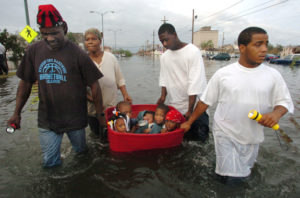
S. Broad Street, August 29, 2005
Something was wrong. The hurricane had passed earlier and it had not rained in hours. So why was the water still rising? Later that day we learned that levees had failed and the city was filling with water. John Rainey, John Rainey, Jr. and Courtney Davis became the first heroes I photographed after Katrina. At least thats what Terry Fox called them after they helped her evacuate the children. — John McCusker
Ten years after Hurricane Katrina landed on the Gulf Coast and exacted a human, social, cultural and economic toll on the region, the rebuilding continues. Although there are signs of improvement and growth, not everyone is benefiting from these gains. Specifically, Black people have not benefited, and in many ways have even lost ground.
Despite the economic recovery in New Orleans, new investments in infrastructure, entrepreneurial growth and more diverse industries, Black residents are having a tough time of it. While the overall economy has made gains, the gap between the haves and the have nots is widening and Black families are struggling, as the Times-Picayune reported.
According to a report released by the Data Center, a nonprofit think tank, “while the New Orleans economy is rebounding, and in some ways better than before, several social and environmental trends may test New Orleans’ resilience capacity in the future.”
The report, “The New Orleans Index at Ten,” states that “In metro New Orleans, employment and income disparities between African Americans and whites are starker than national disparities, and poverty is increasing in surrounding parishes—undermining social cohesion and resilience capacity across the region.” The study added that, “The stagnant post-Katrina income for the poorest New Orleanians suggests that many are not benefiting from the New Orleans economic recovery.”
The Data Center study compared the economic status of Black families and their white counterparts. For example, in 2013, the median income for African-American households in New Orleans was $27,812, which was 54 percent lower than white families in the region, and 20 percent lower than Black families nationwide. Further, while 30 percent of white New Orleans households earned over $105,910, a mere 7 percent of Black families could claim the same. Similarly, 44 percent of Black families and only 17 percent of white households earned less than $20,900. The Data center attributes some of these racial disparities to the low educational achievement and high unemployment among Blacks.
In 2013, 57 percent of Black men and 57 percent of Black women were employed, while 77 percent of white men and 64 percent of white women had a job.
In the area of income inequality in New Orleans, the ratio of the top 5 percent of earners to the bottom 20 percent is 15 to 1, while in the U.S. as a whole, the ratio is 9 to 1. In addition, although the top 5 percent in the city earn $189,737 or more each year and the bottom 20 percent make less than $12,301, the bottom 20 percent nationally have an annual pay of $21,433. In addition, poverty has increased to pre-Katrina levels, and has spread out to the parishes outside the city. The city is 27 percent impoverished, as opposed to 16 percent of the New Orleans metro area.
Further, more than 35 percent of Black families in New Orleans—and 50.5 percent of Black children— live below the poverty line, according to the New Orleans Advocate.
Hurricane Katrina and its aftermath had a profound effect on New Orleans middle class. Aside from the fact that New Orleans has lost 100,000 Black people since the storm, the Black middle class lost one of its primary employers when the city fired all 7,500 of the employees in the school system. As New Orleans Public Radio reported, public schools became a major employer of Black people, with mostly Black teachers (71 percent in 2005) teaching a mostly Black school system. Today, Black teachers number under half, replaced by white teachers from outside New Orleans who do not share the experiences of the children they teach.
As Ben Casselman wrote in FiveThirtyEight, New Orleans is a smaller, whiter city, and while the poor was predominantly Black, so were the majority of middle class professionals.
“After Katrina, the patterns changed: The poor are still overwhelmingly black, but the affluent and middle classes are increasingly white,” Casselman said. “Moreover, what remains of the black middle class is graying. Many of the middle-class African-Americans who returned to the city were retired or nearing the end of their careers; younger black professionals, meanwhile, fled the city in search of better opportunities elsewhere.”
In addition, the white middle class was able to rebound, while Black professionals, hit by a double whammy of the hurricane and the recession, were less likely to have the type of wealth to help them recover financially from such a disaster.
One positive development is that New Orleans in the post-Katrina environment has reduced its local inmate population by 67 percent, as Citylab reported. New Orleans used to jail more people per capita than any major city, at four times the national average, and viewed jailing as a business–one which enriched the courts and bail bondsmen through fees and revenue that left the poor detained, and a system the city ultimately could not afford. Before Katrina, Blacks were kept jailed in pretrial detention twice as long as whites, a factor contributing to the “tragically high” Black male unemployment rate. Further, between 1990 and 2004, the cost of operating the New Orleans jail rose from $15 million to $35 million.
Today, petty crimes such as marijuana possession are summary offenses, which means police can no longer arrest and detain people for these offenses. Even still, Louisiana remains the incarceration leader in the country—and in the world—further sapping the economic potential of the Black community.


